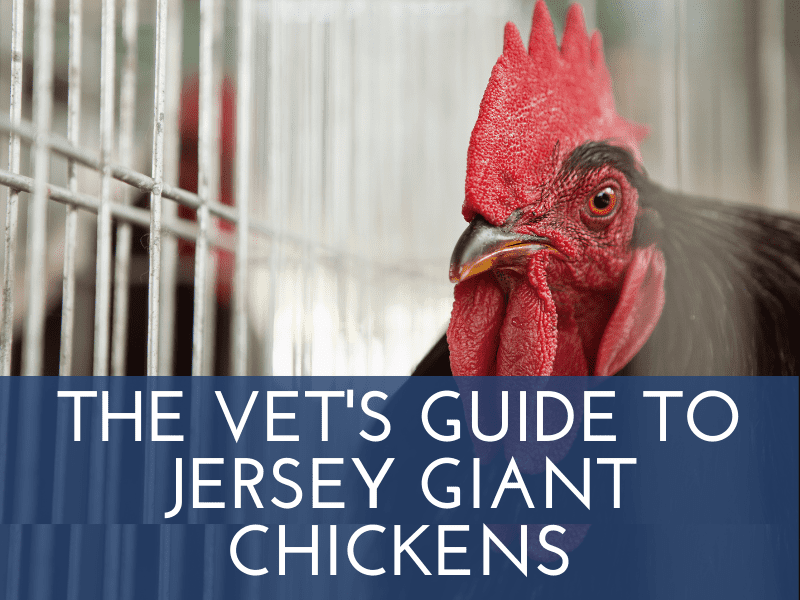In a lot of ways, chicken breeds are like aircraft. There are the tiny microlight bantam-type birds, the regular-size single-cabin backyard laying types, and the massive cargo carriers, that dwarf all the other planes on the runway. In the chicken world, that title sits squarely with Jersey Giant Chickens.
The most common reason I see Jersey Giants at my practice is because of foot and leg conditions caused by heavy landings. Like jumbo jets, the little legs of these massive square birds are disproportionately small compared to the weight of their body. The breed is a treat to own so long as owners know what to expect and set things up to avoid these types of design challenges!
What Are Jersey Giant Chickens?
Jersey Giants are the largest purebred breed of chicken in the world. These friendly birds were specifically bred to be generous-sized table birds, but their laid-back personalities are also reflected in their slow growth rate, so turkey dinners never went out of style.
The lack of interest in the breed because of the long wait to harvest almost led to its extinction. Fortunately, numbers have recovered as more chicken owners discover the joy of owning these dual-purpose birds. Besides meat and eggs, a third category has emerged as Jersey Giant chickens also make excellent pets.
Jersey Giants still appear on The Livestock Conservancy conservation priority list, but fortunately, the breed’s status has been upgraded from threatened to ‘watch.’ Interest in this heritage breed is increasing. Their generous proportions, hardy nature, and docile temperaments are winning the hearts of poultry owners everywhere.
History
In the late 19th century, two brothers in New Jersey, John and Thomas Black, began experimenting with breeding a gigantic breed of chicken. The idea was that if they could create birds large enough, they could replace turkey as poultry meat.
To create the massive breed, three other large breeds were included in the rootstock. These included:
- Orpingtons
- Black Javas
- Black Langshans
The outcome of the breeding program with the original intention was both a huge success and a failure. While the Black brothers did succeed in consistently producing chickens of massive proportions, harvesting a bird with a decent amount of meat can take up to 8 months.
During that time, they also need a lot of feeding since the feed-to-meat conversion ratio is very low. This caused a decline in interest in Jersey Giants in favor of faster-growing breeds.
Jersey Giants were originally called Black Giants in honor of John and Thomas Black, but the name was later changed to Jersey Black Giant. The American Poultry Association recognized the black variety in 1922.
Appearance
Jersey Giant chickens are notable for their impressive size and can show considerable color variation. In addition to their size and color, some other breed-specific features will give clues about whether your neighbor’s giant fowl is a Jersey Giant or another impressively large chicken.
Notable features to look out for when identifying a Jersey Giant:
- They never have leg feathers.
- They have black legs with yellow soles. White birds may have willow-color shanks with yellow soles.
- Short tails
- Flat back and long, wide body, which gives the appearance of having a square shape
- Single red comb
- Yellow skin
- Feathers are arranged neatly and tightly against their bodies
- Brown eyes and black beaks. White birds may have yellowy-tinged beaks.
Colors
By far, the best-known variety of Jersey Giant chickens are jet black. Feathers on these birds shimmer with tones of green or purple when they catch the light. Black was the breed standard recognized in 1922, but since then, it has been extended to include two other color variations.
In 1947 a white Jersey Giants were recognized, and in 2003, blue was added. It is, therefore, possible to find Jersey Giants in all three-color variations, but overall, fully grown black giants tend to be about a pound heavier than the white variety.
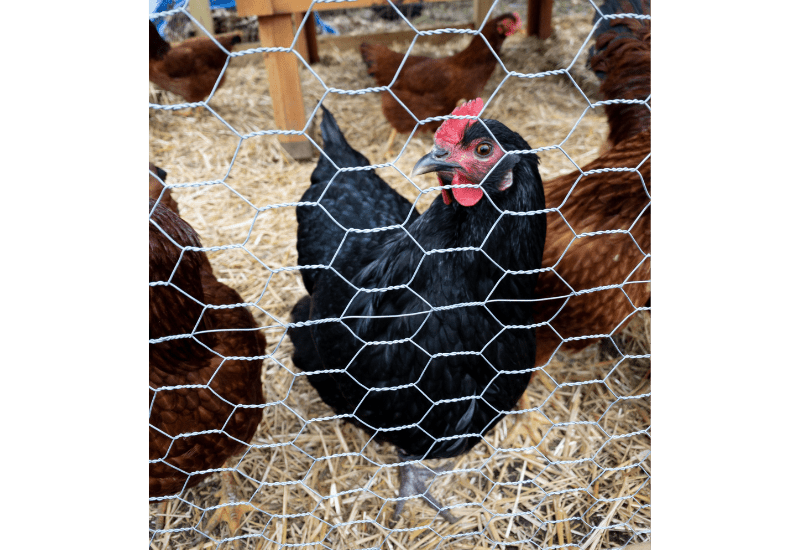
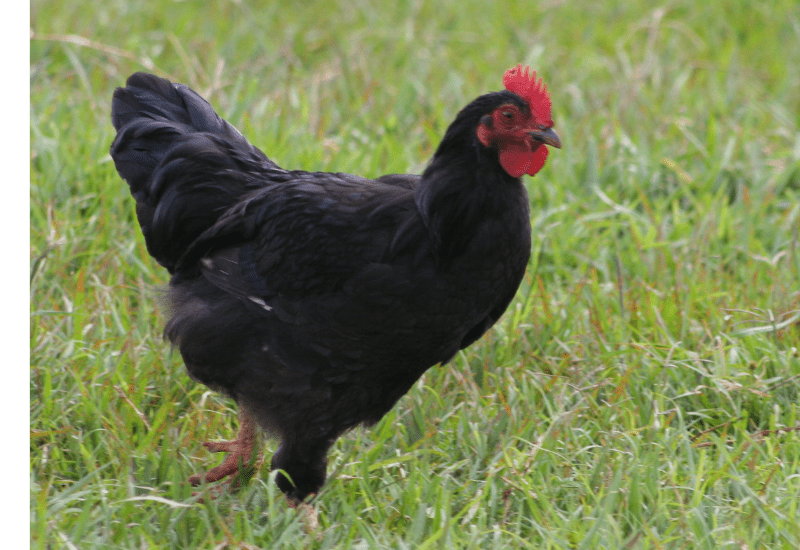
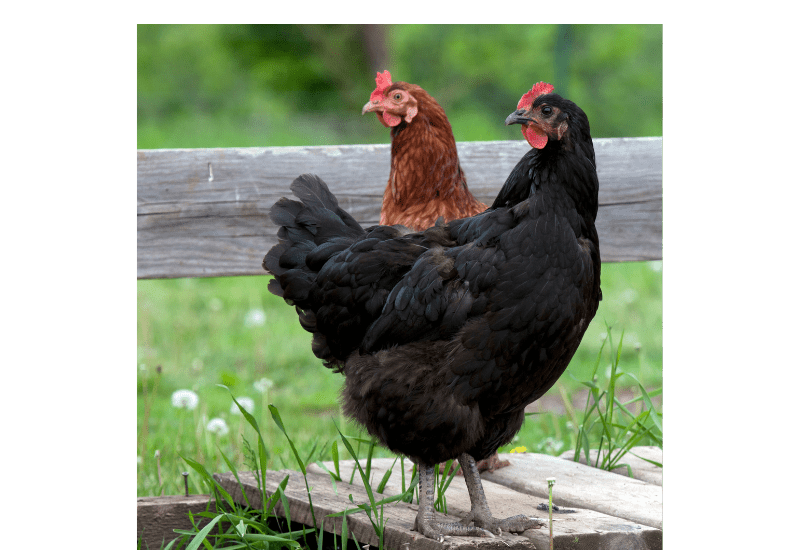
Jersey Giant Chickens’ Size And Weight
If size matters to you, then Jersey Giants are well worth considering. Even poultry owners who don’t use their poultry for meat can find value in the immense size of this breed.
But how big are Jersey Giant chickens?
| Jersey Giant Chickens | Weight | Height |
| Mature rooster | 13 – 15 pounds | 22-26 inches |
| Mature hen | 10 -11 pounds | 16 – 20 inches |
Many poultry predators would have a hard time carrying away such an enormous chicken! This makes them an ideal choice for poultry owners who struggle with frequent visits from birds of prey.
Jersey Giant Rooster Vs. Hen? How To Tell The Difference
Like most breeds of chicken, it can be tricky to know if they are roosters or hens before they are almost fully grown. As tiny chicks, the males and females are identically adorable, and you may only be able to tell them apart after a few months.
Although there is no color difference between the sexes, roosters and hens are easy to identify once they are mature.
The Differences Between Jersey Giant Roosters and Hens
| Roosters | Hens |
|---|---|
| Notably larger and taller when mature | Smaller than roosters |
| Crow when mature | Do not crow |
| A prominent single comb and large wattles | Small comb and wattles |
| Develop long spurs on their legs | They may have small spur nubs but do not develop long spurs |
| Longer tail feathers but still compact | Much shorter tail feathers |
Egg Production: Are Jersey Giant Chickens Good Layers?
Amazingly, despite their massive proportions, Jersey Giant hens are excellent layers and produce between 150 and 200 large eggs each year. The downside is that you may need to wait nearly a year to get any eggs.
Jersey giants do everything slowly. That includes growing and maturing. Poultry owners who have their hearts set on large meat birds or masses of eggs at record speeds may be disappointed by the slow pace. Getting this breed through to maturity takes a lot of patience and food.
Once the long wait is over, though, giants will lay consistently. They produce larger than standard chicken eggs and usually continue to lay through winter.
What Color Eggs Do Jersey Giant Chickens Lay?
The large eggs produced by Jersey Giant hens are always a shade of light to medium brown. All color variations in the breed produce the same color eggs, so whether you own a white, blue, or black giant, they will lay healthy-looking, creamy brown eggs.
What Age Do Jersey Giant Chickens Lay?
Like everything about Jersey Giant chickens, things happen slowly. These massive birds are slow to mature, and excited poultry owners eager to get their flock to produce eggs will have a long wait ahead if they are rearing them from chicks.
Jersey Giant owners have to wait for around eight months or longer before the appearance of the first eggs. However, the investment in time may be worth it because once they start, they often lay more eggs than other large breeds. They are also well known for continuing to lay through winter, which is a large plus for poultry owners in cold regions.
Are Jersey Giant Chickens Broody?
There is contradictory information about the setting rate of Jersey Giant chickens. Some owners have had little luck getting them to go broody, while others report no problems.
The difference seems to be where the stock originated. Some lines go broody regularly, while others don’t. New Jersey Giant owners hoping to expand their flock naturally should inquire about this before investing from a specific breeder.
While giants are excellent mothers, they can have a bit of trouble seeing their eggs safely through the incubation period. Ensure that nests are deeply padded with soft nesting material, as these heavyweight moms may crack the eggs.
Alternatively, use another easy-brooding breed to incubate fertile Jersey Giant eggs. Another option is to use a small home egg incubator to incubate fertile giant eggs.
Personality
Farm kids worldwide know the true terror of occasionally being chased by an angry rooster. It is a rite of passage for most children of poultry owners and makes for loads of laughter and terrific stories for years to come.
Being chased by Jersey Giant chickens would make the experience even more memorable, as these birds are impressively large compared to most other chicken breeds. Fortunately, kids can relax because, despite their intimidating size, Jersey Giants are generally docile with easy-going characters.
Are Jersey Giant Chickens Aggressive?
If there is a manual somewhere that says that giants should be big and angry, Jersey Giant chickens have never read it. These massive birds that tower over feisty, dramatic bantams are slow to anger and seem unphased by any action around them.
As large as they are, Jersey Giant chickens are one the best breeds for anyone with young children. They are solidly built, friendly, peace-loving birds that rarely display aggressive behavior.
Are Jersey Giant Chickens Friendly?
The gentle giants of the chicken world make excellent pets. Jersey Giants may look intimidating with their large proportions and jet-black eyes, but they are well known for their friendly disposition and gentle nature.
The breed usually gets on well with other poultry breeds and is even accepting of most other pets. Thankfully they have a peaceful outlook on life, and even the roosters are known for their mellow-natured ways.
Are Jersey Giants Good For Novice Chicken Keepers?
Jersey Giants for novice chicken keepers is a yes, a no, and maybe all rolled together. They will be perfect if prospective owners do some research before acquiring this breed and know what to expect, but they may be a terrific disappointment to anyone wanting quick results.
Jersey giants are excellent for novice poultry owners who want to free-range their birds. They are robust, sturdy birds which makes them less attractive to predators.
However, the flip side is that they have a few traits that may not be ideal for first-time chicken owners.
Let’s check the pros and cons of owning giants:
Pros:
- They are gorgeous. Everyone who visits you will comment on their spectacular size, and owning such massive chickens can be an exciting experience.
- Jersey Giants are a cold-hardy breed that will continue to lay through winter.
- They are less likely to be carried off by predators, so they are excellent for anyone wanting to free-range their birds.
- They are friendly-natured chickens that get along with other breeds.
- They are excellent natural foragers that produce large eggs.
- They are non-aggressive, so they are a good choice for families with young children.
- Owning a heritage breed helps to conserve it for the future.
Cons:
- We all know the excitement of rearing pullets and finding the first egg in the nest, especially if you have never owned chickens before. Jersey Giants take a long time to start laying, so unless they are purchased at point of lay, they are not recommended for anyone wanting a quick supply of table eggs.
- Anyone wanting healthy free-range table birds is also in for a long wait. Unlike hefty broiler types, Jersey Giants have an extremely slow feed-to-meat conversion rate.
- Indoor birds will need more space per bird than regular-size breeds. They do much better as free-range birds.
- Giants are notoriously loud. This makes the breed less than ideal for anyone who has neighbors living close by.
- Perches and nests need to be adapted for Jersey Giants. If the perches are too high, the birds tend to crashland when they descend, which frequently results in injuries.
- They cost more to feed. Jersey Giants are huge, slow-growing chickens. Unless you have a lot of space available where they can also forage naturally to supplement their intake, they will require significantly more food than smaller breeds.
- You may need to use an electric incubator or a surrogate broody hen of another breed to hatch eggs. Giants do become broody and are good mothers, but their size can be a challenge while setting.
Jersey Giant Chickens Health
As a heritage breed, Jersey Giants have earned a reputation as hardy, healthy birds. With correct care and feeding, it is an excellent robust breed with a life expectancy of eight years or more.
Providing balanced chicken feed that contains all the vitamins and minerals is especially important when raising this large breed. This will ensure that they develop a solid bone structure and grow to their full potential.
Like all species, there are some conditions that particular breeds are prone to, and for these heavyweights, health challenges may include the following:
- Conditions affecting their feet and legs, including bumblefoot – Those spindly black legs have to carry an enormous load, so owners must make every effort to ensure that perches are low and strong enough to hold them safely. No Jersey Giant chicken in the world will ever win a high jump event, so heights must be kept manageable and landing spaces soft.
- They are prone to overheat – As one would expect, a large black, feather-covered land bird will feel the heat in summer.
- Obesity – not too much of a problem when flocks are free ranged, but certainly something to consider in a coop environment. Large birds need large coops, and this breed does not fare well confined.
- Frostbite – Although Jersey Giants are excellent for poultry owners in cold climates, their large combs may freeze if temperatures drop too low. This can be avoided by providing adequate shelter and adding a safe coop heating system, like a Sweeter Heater, to regulate the temperature.
Jersey Giant Chickens Heat Tolerance?
Most chicken breeds fare better in cooler conditions than in extreme heat, and giants are no exception. Jersey Giants are not recommended for extremely hot climates. They are large birds that can quickly overheat in hot weather.
Of course, it is impossible to control the summer weather, so giant owners must ensure that their chickens can stay cool during heat waves. There are some simple methods to keep them cool:
- Include extra water points
- Ensure that there is plenty of shade
- Add fans in the coops if possible
- Provide cooling snacks like watermelon, cabbage, or cucumber
- Add ice blocks to water bowls
- Be careful not to stress the birds during hot weather.
Where To Buy Jersey Giant Chickens?
If you have decided to expand your flock with this heritage breed which is also the world’s heaviest chicken breed, you may be wondering where to buy Jersey Giant chickens. Numerous suppliers offer day-old chicks for sale online, and they can be ordered sexed or unsexed.
Be sure to purchase stock from a reputable breeder to ensure you receive the correct breed and the birds arrive fully vaccinated and healthy. Better yet, if you know anyone with Jersey Giants, try to obtain a few fertile eggs. That way, you can be absolutely sure of what the parent stock looks like.
Use a small home poultry incubator or pop them under any broody hen you already have to start your giant flock. Don’t give up when day 21 comes, and there is no sign of chicks. Like everything Jersey Giant related, they also take their time hatching; incubation can take two days longer than other chicken breeds.
FAQ
Are Jersey Giants Good To Eat?
Jersey Giants were specifically developed as table birds. The meat is reported to be of excellent quality. They are not common as meat birds because of how slowly they grow. Getting a good-sized roast with a proportionate amount of meat takes up to 8 months.
Are Jersey Giant Roosters Aggressive?
Jersey Giant roosters are lovers, not fighters. They are usually friendly to their owners and may even be tolerant of coexisting with other roosters. Giants, especially the tall roosters, can be intimidating and look a little scary just because of their immense size, but they don’t pick fights with other chickens.
Having said that, it is not a good idea to keep Jersey Giant roosters together with smaller breed hens. Like all roosters, they have one thing on their mind, and their immense weight can injure smaller birds.
Although both roosters and hens have been known to fight potential threats from aggressors, like predators or curious dogs, they rarely become riled up unless they feel threatened. Jersey Giants really are the gentle giants of the chicken world.
If you were excited to learn more about Jersey Giant chickens, hit the share button to get your poultry-loving friends and family on board. Let’s keep this American plus-sized heritage breed thriving!
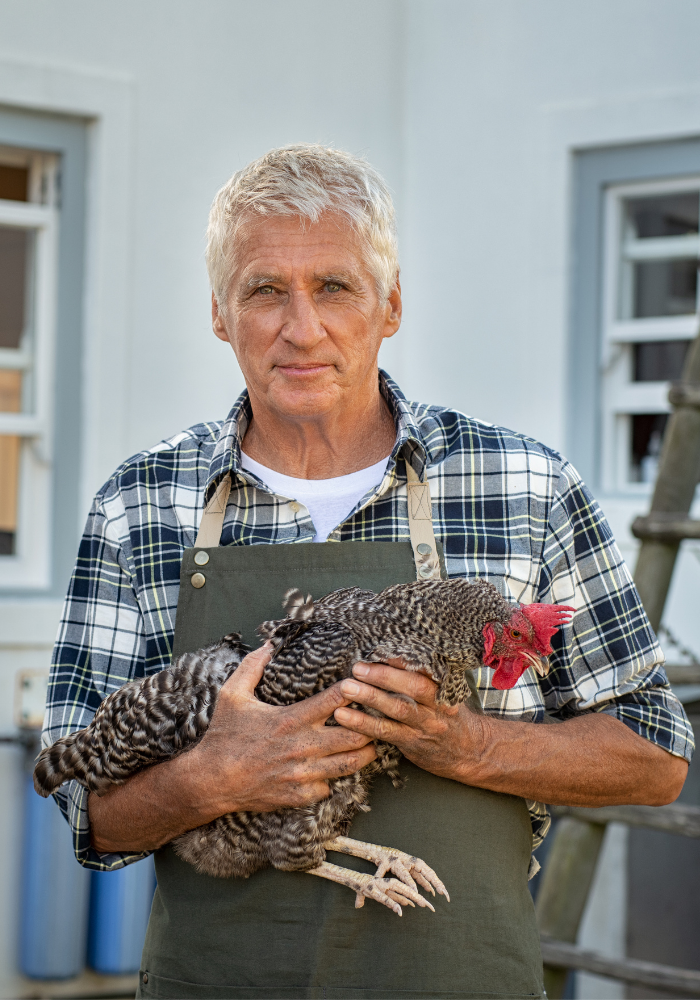
David Cameron is a passionate chicken enthusiast. Growing up, he always wanted to be a veterinarian and loved animals. After graduating from veterinary school, David spent over 40 years as an equine veterinarian. He and his wife retired a few years ago and moved to North Carolina. Here, David’s love of chickens grew even more – he now has 7 chickens and 6 quail. If you have any questions about chickens, feel free to reach out.

